24th Annual Railcar Convention
Weardale Railway, 4th-6th October 2018.
Report by Chris Moxon
Introduction
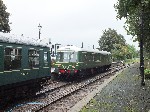 This year's annual gathering for Railcar Association members took place at the Weardale Railway in County Durham, with activities being centred on Stanhope Station. This was the first time the Weardale Railway had hosted the event, although they have had DMU's based on their line since 2001. It was the first time the convention had been hosted in the North East, the tangerine coloured BR signs being somewhat of a novelty! In many ways this was much overdue, as the North Eastern Region of British Railways made extensive use of first generation railcars, with enormous 4-car (and 8-car) sets becoming a trademark for the region. This story is under-represented in preservation, so it was fitting to at last to gather in this spectacular area of the country.
This year's annual gathering for Railcar Association members took place at the Weardale Railway in County Durham, with activities being centred on Stanhope Station. This was the first time the Weardale Railway had hosted the event, although they have had DMU's based on their line since 2001. It was the first time the convention had been hosted in the North East, the tangerine coloured BR signs being somewhat of a novelty! In many ways this was much overdue, as the North Eastern Region of British Railways made extensive use of first generation railcars, with enormous 4-car (and 8-car) sets becoming a trademark for the region. This story is under-represented in preservation, so it was fitting to at last to gather in this spectacular area of the country.
The traction available was similar in format to the previous year's convention: a single unit and a 2-car set, in this case of classes 122 and 108 respectively. Notable was the 108 which was making its first passenger runs on the Weardale Line, following protracted heavy maintenance work after an extended period of use and relocation from the Bodmin & Wenford Railway. This created a mix of low and high density designs, with the classic Derby front end in common.
Friday
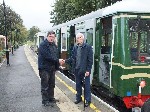 The customary driver experience trips took place using the section of line between Stanhope Station and Scotch Isle Loop (where the main depot is situated) using Class 122 'Bubble Car' E55012, covering a distance of just over five miles each way. The line is varied with a distinct gradient bias one way, requiring control of speed in one direction and power in the other. The high power to weight ratio of a single unit ensured the route was tackled with ease, first gear not even being required to accelerate away from low speed restrictions. The route was peppered with bridges, curves, level crossings and other features with a variety of speed restrictions imposed on them, creating a driver experience with plenty to do and think about. Another unusual (in preservation terms) feature was the radio signalling system with no moving signals (semaphore or colour light), the line instead being controlled by "one man and his laptop", communicating via radio at the correct points which stop boards the driver has permission to pass.
The customary driver experience trips took place using the section of line between Stanhope Station and Scotch Isle Loop (where the main depot is situated) using Class 122 'Bubble Car' E55012, covering a distance of just over five miles each way. The line is varied with a distinct gradient bias one way, requiring control of speed in one direction and power in the other. The high power to weight ratio of a single unit ensured the route was tackled with ease, first gear not even being required to accelerate away from low speed restrictions. The route was peppered with bridges, curves, level crossings and other features with a variety of speed restrictions imposed on them, creating a driver experience with plenty to do and think about. Another unusual (in preservation terms) feature was the radio signalling system with no moving signals (semaphore or colour light), the line instead being controlled by "one man and his laptop", communicating via radio at the correct points which stop boards the driver has permission to pass.
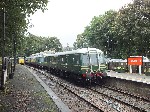 Eight round trips were operated with a variety of participants, most indulging in a round trip each. The flag was well and truly flown with the President, Chairman and Secretary of the association all booking for a drive! Between runs, members talked in the pleasantly heated passenger saloon, with the occasional comment on driving technique aimed at participants as they passed through changing ends! The station buffet at Stanhope was manned and providing all the required food and drink for the day. A common feature of the driver experience days is being able to experience the railway without the hustle and bustle of the main event on the following day, where there are so many people to meet to chat to!
Eight round trips were operated with a variety of participants, most indulging in a round trip each. The flag was well and truly flown with the President, Chairman and Secretary of the association all booking for a drive! Between runs, members talked in the pleasantly heated passenger saloon, with the occasional comment on driving technique aimed at participants as they passed through changing ends! The station buffet at Stanhope was manned and providing all the required food and drink for the day. A common feature of the driver experience days is being able to experience the railway without the hustle and bustle of the main event on the following day, where there are so many people to meet to chat to!
Saturday
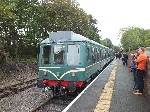 Saturday saw the public part of the event begin, with the railway commencing a 2-train DMU service for the first time. It was also the first opportunity to ride on the ex Bodmin Railway Class 108 which had been out of service for over a year being brought up to passenger carrying standards. More work is needed on the Class 108 to bring it up to the same level as the Class 122 which the line has relied on for most of its services the past 5 years, nevertheless the 108 has been improved greatly since it arrived, with of course much of the progress being invisible, concerning the mechanicals underneath.
Saturday saw the public part of the event begin, with the railway commencing a 2-train DMU service for the first time. It was also the first opportunity to ride on the ex Bodmin Railway Class 108 which had been out of service for over a year being brought up to passenger carrying standards. More work is needed on the Class 108 to bring it up to the same level as the Class 122 which the line has relied on for most of its services the past 5 years, nevertheless the 108 has been improved greatly since it arrived, with of course much of the progress being invisible, concerning the mechanicals underneath.
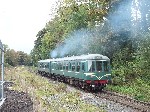 The two train service operated all day, as the railway does not an operational steam locomotive at present the timetable was able to be 100% dominated by the railcars. For those who wishing to attend the event by rail connections were available at Bishop Auckland (which has hourly trains from Darlington), and indeed this option was taken by some members attending Saturday on an "out and back" basis by rail. The line is so long that only a handful of round trips can be made by each unit, and vehicles are moving for longer periods of time than most other heritage lines. As a result, much of the socialising would be on the units themselves whilst travelling up or down the valley. The trick was catching people that were on the other unit!
The two train service operated all day, as the railway does not an operational steam locomotive at present the timetable was able to be 100% dominated by the railcars. For those who wishing to attend the event by rail connections were available at Bishop Auckland (which has hourly trains from Darlington), and indeed this option was taken by some members attending Saturday on an "out and back" basis by rail. The line is so long that only a handful of round trips can be made by each unit, and vehicles are moving for longer periods of time than most other heritage lines. As a result, much of the socialising would be on the units themselves whilst travelling up or down the valley. The trick was catching people that were on the other unit!
Once again lunch was centred around the station buffet at Stanhope, as this was where the bulk of the railway's amenities were located. For those requiring to attend the AGM the timetable allowed for at least one full trip to be made in the morning, followed by a half trip after lunch, not bad for such a long route!
Formal Meeting
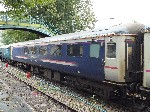 The formal meeting (AGM) was held in a Caledonian Sleeper lounge car of all places! Whilst this arrangement may have been a bit of a squeeze at some conventions, the modest meeting attendance of 22 meant the coach was perfect in terms of capacity. The heating, so cosy it had to be turned off part way through, was in stark contrast to the arctic condition's of last year's meeting space!
The formal meeting (AGM) was held in a Caledonian Sleeper lounge car of all places! Whilst this arrangement may have been a bit of a squeeze at some conventions, the modest meeting attendance of 22 meant the coach was perfect in terms of capacity. The heating, so cosy it had to be turned off part way through, was in stark contrast to the arctic condition's of last year's meeting space!
The meeting began with the opening remarks from Chairman, Paul Moxon, who commented on a "normal" year but with the anticipation of the "pacer revolution". More legislation was coming in and members were warned not to be drawn in too much by the media hype. Thorough risk assessments in most cases were allowing many things to go on the same with only minor alterations. Balance was needed between copying the "big railway" and keeping the hobby alive in a format that it is still worth giving up time for in the first place.
Apologies included Steve Beck, Kevin Dowd, Ben Field, Mike Grimwood, John Joyce, Chris Lings, Ritchie Marcus, Bruce Pollard & Nigel Smith.
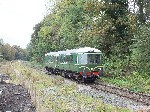 The first presentation was a welcome from the Weardale Railway by Kevin Richardson, Chairman of the Weardale Railway Trust. He explained about the railway in its current form and the paradox of having a 16 mile railway run with only 30 active volunteers. A weekend only operation was run relying on the Class 122 bubble car. His talk centred on the DMU's (for our benefit) and it was explained how they had sought out a 2-car set to support the single unit which was running out of capacity at certain events. The ex-Bodmin 108 was sourced but its condition was well below what was expected. Some brakeblocks were shown to members which emphasised the level of wear that the set had experienced.
The first presentation was a welcome from the Weardale Railway by Kevin Richardson, Chairman of the Weardale Railway Trust. He explained about the railway in its current form and the paradox of having a 16 mile railway run with only 30 active volunteers. A weekend only operation was run relying on the Class 122 bubble car. His talk centred on the DMU's (for our benefit) and it was explained how they had sought out a 2-car set to support the single unit which was running out of capacity at certain events. The ex-Bodmin 108 was sourced but its condition was well below what was expected. Some brakeblocks were shown to members which emphasised the level of wear that the set had experienced.
The next presentation was History of the Weardale Line by John Asquith, also of the Weardale Railway Trust. His interesting narrative took the line from its construction, reason for building and life under BR through to the preservation society being formed in 1993. DMU's had been a part of the story since 1955, although the last passenger services to Wearhead finished in 1953. The line was kept open by cement trains to Eastgate Works until 1993. Post preservation, DMU's returned in the form of Class 141 units in 2001 which lasted until 2018 when they were scrapped. More recently, first generation types had been favoured.
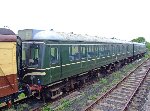 The next presentation was Chris Moxon's usual Round-up of the Year. There had been no additions for the second year running, although Classes 142, 143 & 144 were expected before long. One vehicle had been disposed of (a 117 DMBS) with a further eight on the "at risk" list. Five vehicles, of classes 108, 115 & 117 had moved to new homes, with a further four (of classes 117 & 121) moved as part of contract restoration works. In terms of restorations and overhauls, seven new projects had been started whilst three major and 11 minor projects had been finished. Overall, the number of preserved railcars had decreased slightly and the number operational examples also decreased. The number of restorations underway remained constant. The presentation ended with a final note that after many years of slow decline, exactly 50% of the preserved railcars in the UK were in an operational state, some may say we have reached a 50/50 tipping point? How future "clearouts" and scrappings, plus the preservation of operational second generation vehicles, affects this figure remains to be seen with interest.
The next presentation was Chris Moxon's usual Round-up of the Year. There had been no additions for the second year running, although Classes 142, 143 & 144 were expected before long. One vehicle had been disposed of (a 117 DMBS) with a further eight on the "at risk" list. Five vehicles, of classes 108, 115 & 117 had moved to new homes, with a further four (of classes 117 & 121) moved as part of contract restoration works. In terms of restorations and overhauls, seven new projects had been started whilst three major and 11 minor projects had been finished. Overall, the number of preserved railcars had decreased slightly and the number operational examples also decreased. The number of restorations underway remained constant. The presentation ended with a final note that after many years of slow decline, exactly 50% of the preserved railcars in the UK were in an operational state, some may say we have reached a 50/50 tipping point? How future "clearouts" and scrappings, plus the preservation of operational second generation vehicles, affects this figure remains to be seen with interest.
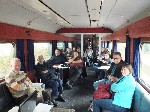 The next preservation was a historical interest item by Evan Green-Hughes, looking at the origins of the first generation DMU. The start was a move at the turn of the 20th century to experiment with internal combustion versions of the steam railmotor. The limits of the early petrol engines limited the technical advances until the 1930's when diesel engines became sufficiently powerful for the likes of the GWR railcars to emerge, although these are the most well known there were a string of other designs and experiments through the 1920's & 1930's that contributed. Post second world war economies created the right conditions required for BR to back a lightweight design of train for cost cutting railways that needed to survive into the future, and the lightweight trains committee was born which, in essence, created the first generation DMU fleet as we know them today. From the inception of the committee in 1951 to having large fleets being produced from 1954 is an exceptional achievement by any standards.
The next preservation was a historical interest item by Evan Green-Hughes, looking at the origins of the first generation DMU. The start was a move at the turn of the 20th century to experiment with internal combustion versions of the steam railmotor. The limits of the early petrol engines limited the technical advances until the 1930's when diesel engines became sufficiently powerful for the likes of the GWR railcars to emerge, although these are the most well known there were a string of other designs and experiments through the 1920's & 1930's that contributed. Post second world war economies created the right conditions required for BR to back a lightweight design of train for cost cutting railways that needed to survive into the future, and the lightweight trains committee was born which, in essence, created the first generation DMU fleet as we know them today. From the inception of the committee in 1951 to having large fleets being produced from 1954 is an exceptional achievement by any standards.
Less formal discussion followed concerning a variety of technical topics including the Office of Rail and Road's concern on the continued use of droplight windows. Several members already had experience of what heritage railways were doing right now to combat the recommendations, and advise concerning correct signage, risk assessments etc was given. At the moment, most of the work required (such as reviewing lineside structures etc) was more appropriate for the host heritage lines rather than the DMU owners themselves, although obviously working together was a theme.
 One item questioned was the bemusing article published by the normally neutral Railway Magazine, stating that the preserved DMU world could be threatened by the arrival of the Pacers next year. Members were questioned over whether anyone had given any statements on behalf of the association, nobody had, so we are none the wiser as to where their information to publish that story originated from. On the contrary, the almost open hatred of the Pacer fleet by most of the boards of directors of traditional heritage railways would ensure they had little chance of usurping the mush more "steam friendly" first generation fleets. The view of the floor was that the second generation units would probably be preserved elsewhere and prove more of an addition rather than a threat. Second generation units follow similar maintenance regimes to their older counterparts and as existing second generation knowledge already exists within the organisation (reference Evan Green Hughes!) future owners would do well to join in as the first generation owners have.
One item questioned was the bemusing article published by the normally neutral Railway Magazine, stating that the preserved DMU world could be threatened by the arrival of the Pacers next year. Members were questioned over whether anyone had given any statements on behalf of the association, nobody had, so we are none the wiser as to where their information to publish that story originated from. On the contrary, the almost open hatred of the Pacer fleet by most of the boards of directors of traditional heritage railways would ensure they had little chance of usurping the mush more "steam friendly" first generation fleets. The view of the floor was that the second generation units would probably be preserved elsewhere and prove more of an addition rather than a threat. Second generation units follow similar maintenance regimes to their older counterparts and as existing second generation knowledge already exists within the organisation (reference Evan Green Hughes!) future owners would do well to join in as the first generation owners have.
A further item concerned bogie overhauls by a firm which will be looked into by committee members in more detail. It is a new firm offering set price overhauls and they are willing to move into DMU bogies if the demand is there. Previous struggles getting DMU bogie overhauls through heritage railway machine shows meant this was certainly worth looking at at least. A spin off conversation started from this topic concerning new defects we are now seeing and how the maintenance regimes should be reviewed where possible to reflect that we are still current given our railcars are now that much older.
Members were then thanked and sent on their way by the hosts and Chairman, in good time for the Fish & Chip special!
Fish & Chip Special
The traditional fish and chip special departed at 17:45 for a return trip to Bishop Auckland, again connecting with a Network Rail service for those heading home by rail. A choice of sausage or fish with chips was enjoyed, cooked in house at Stanhope. The Class 108 was used and headed back to Stanhope as the light turned to dark. The earlier start time was selected as such good feedback was received when this was trialled at the Epping & Ongar event last year.
Sunday
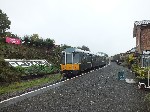 Most members headed home on the Saturday evening however further running was enjoyed with the Class 108 & 122 on the Sunday, which also allowed those who were engaged on the Saturday to also join. Although not part of the event, a small party of six members headed to the Wensleydale Railway on their way back south as their Class 121 bubble car was also by chance in operation on ordinary services.
Most members headed home on the Saturday evening however further running was enjoyed with the Class 108 & 122 on the Sunday, which also allowed those who were engaged on the Saturday to also join. Although not part of the event, a small party of six members headed to the Wensleydale Railway on their way back south as their Class 121 bubble car was also by chance in operation on ordinary services.
Future Events
The next convention will be held at the Mid Norfolk Railway. It will celebrate a quarter of a century of groups gathering, which brings the possibility of doing "a few extras". Plans are being made for the possibility of some branded merchandise provided there is demand for it to celebrate the 25 year milestone.
The date for the convention has yet to be confirmed but the 2nd-4th October 2020 has been requested. Traction will centre around the Mid Norfolk Railway's Class 101 collection, with the possibility of a visitor if the arrangements are possible. There will of course be an extended and much developed railway to play on following all the achievements that the railway has made since we last visited almost 20 years ago!
The 2021 event is still TBC but it is increasingly important to lay the groundworks early as heritage railways are "locking in" their calenders earlier and earlier these days, and October is quite late to be knocking on the door to insert an event in place. We are there in informal talks for a potential 2021 venue which may be announced in name only at some point, or at the 2020 convention at the latest.